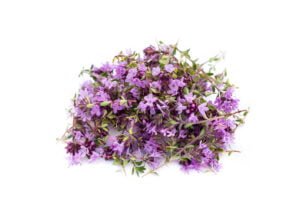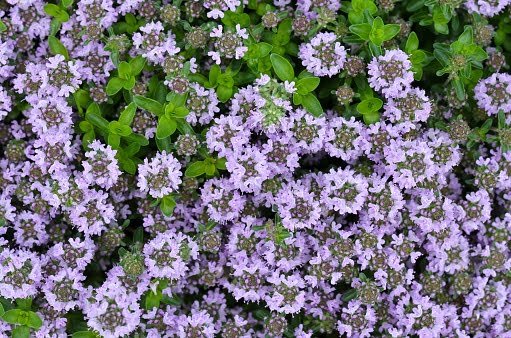Creeping thyme
Creeping thyme, often known as ‘Mother of Thyme,’ is a spreading thyme cultivar that is easy to grow. It works well as a grass substitute or as part of a living patio with stepping stones or pavers. Let’s discover more about how to care for a creeping thyme plant.
Facts about Creeping Thyme
Thymus praecox is a low-growing perennial hardy in USDA hardiness zones 4–9. It requires very little care. This creeping thyme variety is an evergreen with sparsely hairy leaf that grows in low, dense mats that sprawl randomly and swiftly fills in areas as a ground cover, rarely exceeding 3 inches or 7.5 cm in height. Another creeping thyme cultivar is T. serpyllum.
When crushed or steeped for teas or tinctures, creeping thyme, like other thyme cultivars, has a flavor and perfume similar to mint. Remove the leaves from the stems of creeping thyme ground cover or dry them by snipping from the plant and hanging them upside down in a dark, well-aerated place when the plant’s essential oils are at their optimum; harvest creeping thyme early in the morning.
Another interesting aspect about creeping thyme is that it is deer resistant despite its appealing odor, making it a perfect landscape contender in deer-infested areas. Creeping thyme can also endure being tromped on by energetic children (making it kid resistant! ), making it an excellent choice for planting in areas with a lot of foot traffic. Flowering creeping thyme attracts bees and is a great addition to a honey bee-friendly garden. The pollen from the flowering thyme will flavor the honey.
Creeping Thyme Planting Instructions
Due to its compatibility with a wide range of soils and light exposures. Although this ground cover favors well-drained, light-textured soils, it will grow in various less-than-ideal conditions and flourish in full sun to moderate shade. Because the creeping thyme plant is vulnerable to root drowning and edema, the soil should be kept damp but not wet. The soil pH should be neutral to slightly alkaline while cultivating creeping thyme plants.
Creeping thyme ground cover can be propagated via stem cuttings or divisions, and it can also be acquired as established plantings or seeds from a local nursery. Early June is the best time to harvest cuttings from the creeping thyme plant. Seeds can be started indoors when growing creeping thyme, or they can be sown outside when the threat of frost has gone in the spring.
To allow for the proliferation of creeping thyme, space plants 8 to 12 inches (20-30.5 cm) apart. If additional shaping is desired, prune creeping thyme ground cover in the spring to keep a compact appearance and again after the little, white blooms have faded.
Growing Suggestions
- Choose a sunny location with well-draining soil.
- Weed the area and smooth out any clumps of soil.
- Directly sow seeds or plant starts.
- Seeds should be watered every day until they germinate.
- Allow plenty of room for each plant to flourish.
- As the plants mature, reduce the watering, you give them.
Maintenance and Pruning
praecox is a rather hands-off garden guardian once established. All these plants truly require is a little water now and then – but not too much, as they may easily get oversaturated.
Because T. praecox grows in poor soil, fertilizer is not recommended. Within the first several years, this plant will aggressively expand. The original parent component of the plant will become thin after three to four years and should be divided as stated above to foster healthy, new growth.
Keep in mind that while dense plantings give an immediate lush appearance, the plants will struggle to access the sun over time, resulting in less healthy, leggier growth. To avoid this, thin out your plants or move divisions to different parts of your garden so that each one has enough room to thrive.

[…] Creeping thyme care and plantation […]